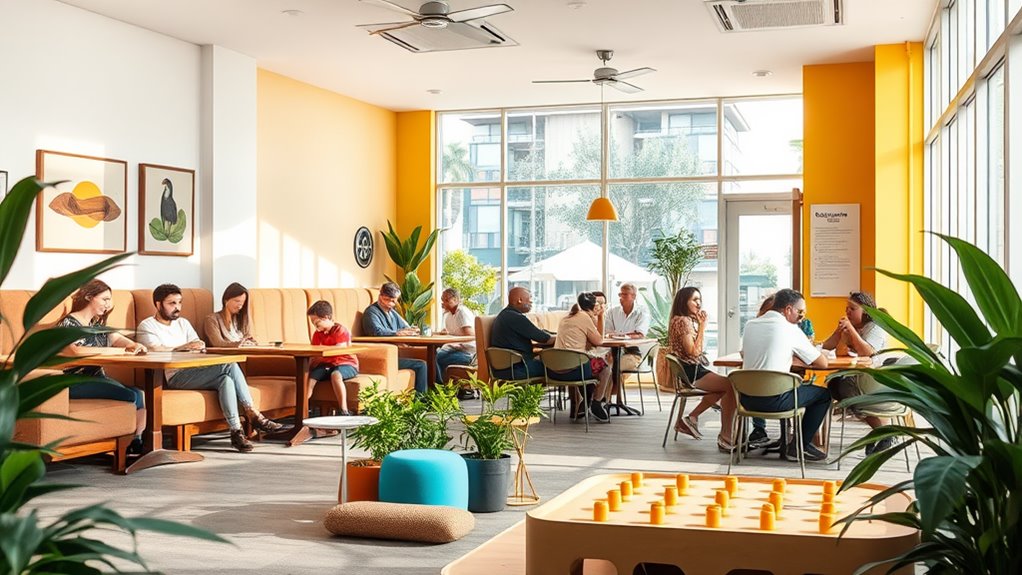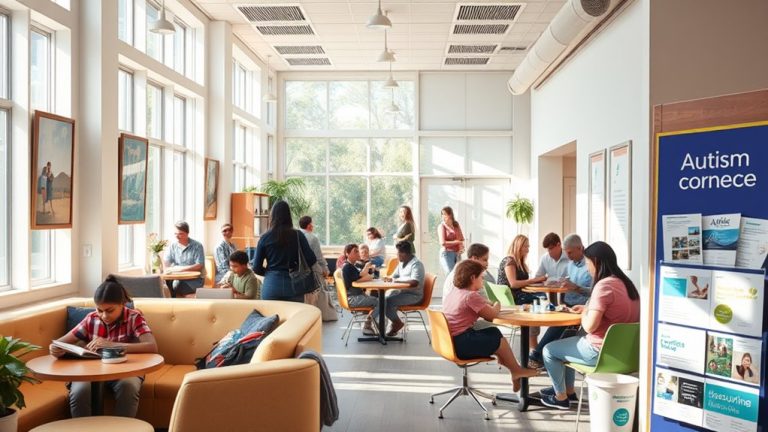Building inclusive spaces for autistic individuals is a game-changer for businesses in 2025. Imagine sensory-friendly environments with adjustable lighting and quiet zones—pretty cool, right? You’ll also see flexible work options that let employees personalize their spaces. Plus, community engagement will be key! Want to know how all this can enhance employee satisfaction and retention? Let’s investigate the amazing concepts that can make your workplace more inclusive and welcoming for everyone.
Understanding Autism and Its Impact on Business
Understanding autism is crucial for creating a workplace that thrives on diversity. Autism Spectrum Disorder (ASD) affects communication, social interactions, and sensory experiences. This means you need to recognize these differences to support neurodiverse individuals effectively.
By raising neurodiversity awareness, you can foster an inclusive environment where everyone feels valued.
Implementing effective communication strategies is key. For instance, using clear, direct language can help avoid misunderstandings.
Remember, many autistic individuals have incredible strengths like attention to detail and problem-solving skills. When you accept these qualities, it not only enhances productivity but also sparks innovation.
Let’s be real—creating an autism-friendly workplace isn’t just ethical; it opens doors to a wider customer base and a richer working environment.
Designing Sensory-Friendly Environments
Creating sensory-friendly environments is all about making spaces that work for everyone. By using sensory design principles, you can minimize sensory overload. Think adjustable lighting, soundproofing, and quiet zones that really help those with autism. It’s all about comfort and focus!
When designing, consider inclusive layout strategies. Good acoustics cut down on noise distractions, while spatial sequencing helps people move logically through a space. You should also empower users by giving them choices in their surroundings.
Involving autistic individuals in the design process is key; their input guarantees the environment meets their needs.
Research shows that these thoughtful designs can improve focus, learning, and social connections. So, let’s create spaces that benefit not just individuals with autism, but everyone!
Implementing Flexible Business Models

After we’ve crafted sensory-friendly environments, it’s time to look at how flexible business models can make a real difference for autistic employees. Embracing remote work lets you create personalized sensory-friendly spaces that enhance focus and reduce anxiety. Plus, flexible scheduling accommodates unique needs, allowing you to work during your peak hours without the stress of rigid routines.
Here’s a quick look at how these models can help:
| Flexible Model | Benefits |
|---|---|
| Remote Work | Creates a calming, personalized space |
| Flexible Scheduling | Aligns work hours with productivity peaks |
| Feedback Integration | Guarantees strategies meet specific needs |
Fostering Community Engagement and Collaboration
When you think about building a supportive community for autistic individuals, it’s clear that collaboration is key.
You can kick things off by hosting community workshops that educate everyone about autism. These events foster understanding and acceptance, which makes a huge difference.
Partnering with local organizations, businesses, and schools helps create resource networks that empower autistic individuals and their families.
Plus, when you gather feedback from autistic individuals, you can design spaces that truly meet their sensory and social needs.
Don’t forget about teaming up with advocacy groups to amplify awareness campaigns.
Engaging in volunteer programs that connect neurodiverse individuals with mentors can strengthen community ties.
Together, you can create an inclusive environment that benefits everyone!
Training Staff for Inclusivity and Support

Training staff for inclusivity and support is a game-changer in any workplace. When you equip your team with knowledge about autism and neurodiversity, everyone’s experience improves.
Using role-playing scenarios in training makes a real difference. It helps your staff understand the unique challenges autistic individuals face, fostering empathy and connection.
Regular workshops on communication strategies, like the PAUSE technique, teach clear and effective interactions, reducing misunderstandings.
Plus, involving autistic individuals in the training process offers insights that lead to better support strategies. Companies that prioritize this training often see a 30% increase in employee satisfaction and retention.
Conclusion
Creating spaces that welcome everyone is like building a bridge. This bridge connects unique minds, fostering understanding and acceptance. By designing sensory-friendly environments, embracing flexibility, and engaging with the community, we can make workplaces vibrant and supportive. Training staff on neurodiversity is the final touch that guarantees everyone feels valued. Together, let’s pave the way for a future where all individuals can thrive, bringing their unique colors to the canvas of our workplaces!
